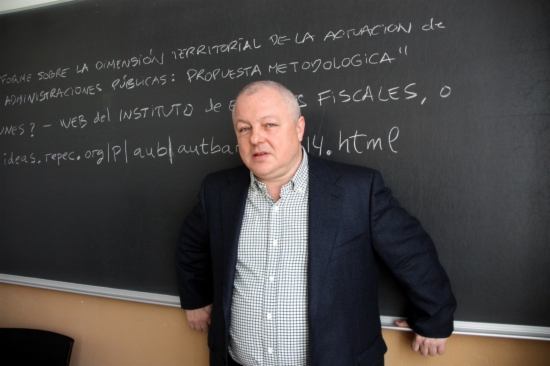24.07.2014 - 11:44
Yesterday, finally, the Spanish Government published the public accounts, edited by economist Ángel de la Fuente, executive director of FEDEA. According to the resulting calculations, the Catalan fiscal deficit is reduced to 8.5 billion euros—some 4.35% of its GDP—while, using the same methodology, the Catalan Government had calculated that the deficit was 11 billion euros. Marta Espasa, professor of Political Economics and Public Finance at the University of Barcelona explains where the holes are in the Spanish Finance Ministry’s accounts.
The 8.5 billion euros of fiscal deficit are the difference between the almost 9.4 billion euros that the State collects in tax receipts in Catalonia and the 910 million euros that it spends there, according to this data. The report calculated the fiscal deficit of the autonomous communities with respect to the central administration using the benefit approach, and they omitted using the cash-flow method altogether. When the Catalan Government calculates the fiscal balances, it uses both methods.
Discrepancies with Catalan Government Data
This data, which comes from 2011, contrasts with what was published recently by the Catalan Government for the same year, which noted a deficit of 11 billion euros, or 5.7% of the GDP, using the same calculation method. With the cash-flow approach, the difference is still wider, indicating a fiscal deficit of 15 billion euros or 7.7% of the GDP.
Suspicious calculations
Yesterday, the president of the Catalan Government, Artur Mas, said in the Catalan Parliament that he considered it “suspicious” that Montoro’s team only used one method for calculating the deficit, that which offers a lower figure. “They have omitted calculation methods out of purely political motives,” he said. The Catalan Minister of Finance Andreu Mas-Colell explained, “The Spanish Government considers Catalonia’s fiscal deficit calculated with the benefit approach to be 25% less than what we have calculated in Catalonia. Out of academic respect, we will analyze their report line by line, hypothesis by hypothesis, to explain this discrepancy.”
How do the two methodologies for calculating the fiscal deficit differ?
There are two methods for calculating the fiscal deficit: the benefit approach and the cash-flow approach. Both are considered academically valid, but they respond to different questions.
If we want to know the difference between the amount of money that the State collects from an autonomous community compared with the spending that it does there, we’d use the cash-flow approach. With this methodology, we only compute the central administration spending that takes place in a given geographical area.
In contrast, with the benefit approach, state spending both in a given community as well as in other communities is taken into account. Why? Because in this method, some of the State’s centralized services, like the Ministries, despite being concentrated in a particular region themselves, benefit all of the State’s citizens. The typical example is the Prado Museum, which according to the benefit approach benefits all of the citizens of the Spanish State to the same degree despite the fact that it is located in Madrid and the economic activity that it generates takes place in the Spanish capital.
According to the Generalitat, the first method, the cash-flow approach, describes the impact of State administration spending in the economies that receive that spending better than the benefit approach. In contrast, the team that wrote the accounts presented yesterday had the opposite opinion. And indeed, they didn’t bother to use the cash-flow approach at all.
The calculations, however, even though they were made using the same methodology, still differ with those from the Catalan Government. The State came up with a figure of 8.5 billion euros of fiscal deficit compared with 11 billion euros, according to the Catalan Government.
Arbitrary criteria
Professor Marta Espasa explains that the benefit approach serves to calculate who benefits from public spending and therefore evaluate each of the State’s spending programs. For example, who does the Prado Museum benefit? There are different criteria for calculating that benefit, according to Espasa: “those who live closest”, “all citizens”, or even “according to income”, since studies show that people with higher incomes spend more on cultural goods. Which criteria should be chosen? The most appropriate one.
“The criteria is arbitrary,” says Espasa, since the calculation of the spending depends on adopted criteria, except for direct transfers like retirement pensions. In contrast, the cash-flow approach, she says, “is much more objective” because the spending is accounted for in the place where it is made.
If the administration invests money in Catalonia, the cash-flow approach attributes this spending to Catalonia; on the other hand, with the benefit approach this calculation is made according to previously established criteria to evaluate to whom it benefits, without taking into account in which community the spending takes place.
“I’ve never seen this before”
Espasa explained that one of the novelties of the ‘territorialized public accounts” is that the taxes ceded to the autonomous communities and the local institutions are incorporated into the income of the central administration. For example, the inheritance tax, local property tax, various excise taxes.
“I’ve never seen this before,” said Espasa. The Spanish Government “blurs the fiscal balances, that’s why they don’t speak about them exactly, and instead talk about “territorialized public accounts”.
Neutralizing the deficit
The income that the State administration collects is not sufficient to cover all of the spending; therefore, there is a deficit—the difference between tax receipts and spending—that is financed with debt. What does it mean to “neutralize” the debt? To take this variable into account. Espasa explains that both the Catalan Government and the Spanish Government neutralize it, when calculating the fiscal balances, but the criteria that they use to calculate the part of the debt that Catalonia assumes are different.
On the one hand, according to the Catalan Ministry of Finance, one must consider that Catalans assume their part of the debt of the State treasury according to the proportion of their income (about 18%). “It’s obvious that the debt will be paid with future taxes,” says Espasa. And on the other hand the Spanish Government distributes the responsibility of the debt according to population (16%, in the case of Catalonia).
Fudging the taxes paid by tourists
One of the other contradictions pointed out by Espasa is that the Ministry of Finance’s accounts do not include taxes paid by tourists—basically VAT and other special taxes—as income that comes from the autonomous communities. This has a particularly large effect on Catalonia, Valencia, and the Balearic Islands which have huge amounts of tourism.
That is, the taxes that tourists pay in Barcelona, for example, are not considered income that comes from Catalonia, but rather is distributed equally throughout the Spanish state. Why? These taxes are not paid by residents. Espasa would consider it reasonable if the same adjustment was made for spending. And she gives an example: a portion of the investment made in the Barcelona airport benefits tourists, and instead is counted as solely benefiting Catalan residents.
In short, according to Espasa, these adjustments in the Spanish Government’s calculations serve to reduce the total amount of income that comes from Catalonia in order to make the fiscal deficit look smaller.




